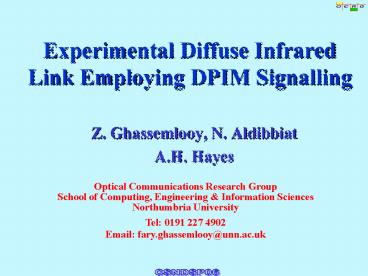Experimental Diffuse Infrared Link Employing DPIM Signalling - PowerPoint PPT Presentation
1 / 27
Title:
Experimental Diffuse Infrared Link Employing DPIM Signalling
Description:
School of Computing, Engineering & Information Sciences ... Isochronous. PIWM. PIM. PFM. SWFM. PWM. PPM. MDPIM. CSNDSP06. Pulse Modulation Symbol Structure ... – PowerPoint PPT presentation
Number of Views:38
Avg rating:3.0/5.0
Title: Experimental Diffuse Infrared Link Employing DPIM Signalling
1
Experimental Diffuse Infrared Link Employing DPIM
Signalling
- Z. Ghassemlooy, N. Aldibbiat
- A.H. Hayes
Optical Communications Research Group School of
Computing, Engineering Information
Sciences Northumbria University Tel 0191 227
4902 Email fary.ghassemlooy_at_unn.ac.uk
2
Outline of the Presentation
- Introduction
- DPIM Symbol Structure
- System Overview
- Link Setup
- Results
- Conclusions
3
Introduction
Hybrid
Directed
Non-directed
Line-of-Site
Non-Line-of-Site
4
Diffuse Scheme
5
Pulse Time Modulation Tree
MDPIM
6
Pulse Modulation Symbol Structure
7
Modulation Techniques Comparison
8
Modulation Techniques Comparison, cont.
9
Modulation Techniques Comparison, cont.
10
DPIM System Block Diagram
11
DPIM Transmitter Block Diagram
12
FPGA
In order to download data to the 32K RAM, the
FPGA is configured using a wr_mem module
The rd_mem module interfaces the modulator with
the 32K RAM
13
Schematic Diagram of DPIM Modulator
14
Drive Circuit
15
Optical Transmitter
Comprising of an FPGA development board and an
array of 12 infrared LEDs with the corresponding
drive circuitry.
16
Receiver Optical Front End
17
Receiver Post Amplifier
18
Bessel Low-Pass Filter (4th Order)
Threshold Detector Guard Slot Generator
19
Optical Receiver
Comprising of an optical front-end (with some
amplification stages), a clock recovery circuit
and signal regeneration circuitry.
20
Practical Link Setup
Positions of transmitter and receiver
21
Practical Link Setup, cont.
Positions of artificial ambient light sources
22
Average Background Photocurrent
23
Results
SER vs. average received irradiance in the
presence of natural light with fc ? 48 kHz
Darkness 43.4 dBm/cm2 irradiance is required to
achieve SER of 10-5 Daylight 1.2 dB optical
power penalty incurred due to 40 - 50 ?A shot
noise Optical filter reduces shot noise by 70
but improves power penalty by only 0.2 dB Ideal
system (limited only by 50 ?A shot noise)
requires 3.2 dB average optical power less than
daylight with no optical filter
24
Results, cont.
SER vs. average received irradiance with various
artificial ambient light fc ? 48 kHz
Incandescent photocurrent incurs 2.3 dB average
optical power penalty compared with the darkness
case Optical filter slightly attenuates the
signal photocurrent (by 1.4 dB)
25
Conclusions
- Experimental 2.5 Mbps 16-DPIM diffuse infrared
link has been examined under a variety of ambient
light conditions. - An electrical high pass filter with cut-on
frequency of 48 kHz (corresponding to a
normalized delay spread of 0.02) was found to be
sufficient to reject the interference signal from
all the artificial ambient light sources. - Using this cut-on frequency requires an average
received irradiance of -43.4 dBm/cm2 to achieve a
SER of 10-5 when operating in darkness. - 1.2 2.3 dB average optical power penalties are
incurred when operating in the presence of
daylight, an incandescent bulb or a low-frequency
fluorescent lamp. - Optical filtering gives a 1 dB reduction in the
average optical power penalty.
26
Results, cont.
Eye diagram at pre-detection filter output for
incandescent bulb without optical filter
All 12 LEDs were switched on 48 mW average
optical transmit power The closing of the eye is
significant due to incandescent light shot noise
27
DPIM Code Properties































